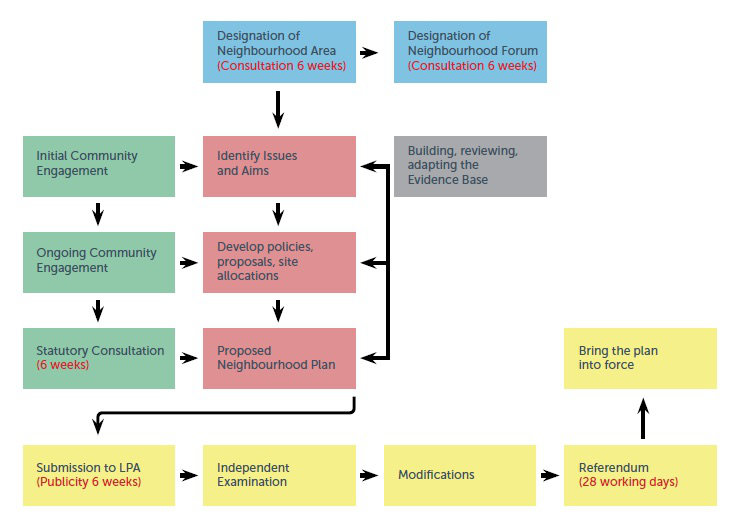Introduction
Neighbourhood planning is a right for communities introduced through the Localism Act 2011. Communities can shape development in their areas through the production of Neighbourhood Development Plans, Neighbourhood Development Orders and Community Right to Build Orders.
Neighbourhood Development Plans become part of the Local Plan and the policies contained within them are then used in the determination of planning applications. Neighbourhood Development Orders and Community Right to Build Orders allow communities to grant planning permission either in full or in outline for the types of development they want to see in their areas.
It must be stressed that the policies produced cannot block development that is already part of the Local Plan. What they can do is shape where that development will go and what it will look like.
Neighbourhood planning is one of the community rights, along with the Community Right to Build, Community Right to Bid, Community Right to Challenge and Community Right to Reclaim Land. See the My Community Rights website for more information.
How does it work?
In our case we are setting up a community group known as a neighbourhood forum to lead on neighbourhood planning. The Local Planning Authority is involved and will make decisions at key stages of the process (see process map below), such as approving the neighbourhood area within which the Neighbourhood Development Plan will have effect. It will also organise the independent examination of the plan and the community referendum that is held at the end of the process.
Our ultimate goal is to define a vision and development plan for our area that will help us to deliver our charitable objectives. Our plan should be realistic and achievable, detailing what we would like our area to be like in 15 or 20 years time.
There will then have to be:
Consultation and Engagement (on the Draft Plan)
Check proposals with landowners or site-owners to ensure any proposals are deliverable and realistic Check draft Neighbourhood Plan with community and other stakeholders (Police, Environment Agency etc) to ensure there is general support.
Independent Examination:
An independent examiner will be appointed to check that the Neighbourhood Plan:
Conforms with the Local Planning Framework & The National Planning Policy Framework, i.e. its policies don’t clash with those already in place at the national and local scale.
Is sound i.e. the policies and proposals in the Plan are based on evidence, deliverable and viable i.e. realistic
Note: An independent examiner is jointly appointed by the Council and the Forum but paid for by the Council
Referendum:
If the Plan passes the Independent Examination, a referendum will be held in the local area to decide if it should be adopted by the Council i.e. it becomes a formal document that will influence planning decisions in the Rooley Moor area. The referendum will normally be open to any individual registered to vote in the Neighbourhood Plan area. For the plan to be adopted, more than 50% must vote in support of it.
For more information about neighbourhood planning, see A plain English guide to the Localism Act
This process is probably going to take two years to complete, but once in place it will give us a say in how we’d like to see our area develop in the coming years. Listed below are some ideas and we welcome your input to add to this list:
- Promote local history and conservation of our area
- Develop a plan to protect, preserve and enhance the landscape, antiquities, flora and fauna, natural beauty and cultural heritage of the area
- Study, record and publish information upon the antiquities, history and natural history of the area
- Make information about our area readily available for everyone to access
- Provide information boards at points of historical interest
- Enhance and preserve of the fabric of the area
- Enhance and preserve of the vernacular architecture of the area
- Preserve ancient sites and listed buildings in our area
- Promote use of the area by the public
- Promote activities with known health benefits (eg walking, riding, running)
- Improve public rights of way in the area, providing easier access for abled and disabled people
- Encourage volunteering through the advancement of community activities
- Engage the public in rural crafts (eg dry stone walling, footpath maintenance)
- Seek funding to develop the recreational use of local facilities
- Source funding to improve and protect the assets of our area
- Visitor centre Designated walks, history trails, Heritage & History of the Area (Famine Road and other)
- Conservation Prickshaw – Catley Lane Head (Gateway to Rooley Moor) and Fern Hill
- Community facilities
- Support sensitive and sustainable development
- Improve our area (Undergrounding electricity cables, improve roads, paths, walls, drainage)
- Connect to Rochdale town centre and adjoining neighbourhood
A flow chart of the process

Where Next For Neighbourhood Plans?
At our AGM on Thursday 21st November 2019 we agreed not to submit our Neighbourhood Plan for external examination.
To help understand some of the reason why, we suggest you click HERE to read a report produced in October 2018 by The National Association of Local Councils (NALC).
Some of the other reasons are detailed at item 9, Neighbourhood Plan, in the AGM Agenda & Reports Pack.
Minutes of our AGM are published HERE.
Our Neighbourhood Plan and associated documents can be accessed for reference by clicking on the links below:
- See the Neighbourhood Plan and its policies – Revised 29th November 2018 to reflect the updated National Planning Policy Framework (NPPF) – July 2018
- Download the Neighbourhood Plan Community Questionnaire Analysis
- See the detailed Community Questionnaire Analysis Report that help define the Plan
- See the Consultation Statement – Updated November 2018
- See the Basic Conditions Statement
- See the Strategic Environmental Assessment (SEA )and a Habitats Regulations Assessment (HRA) screening report
For more information about Neighbourhood Planning please see the Neighbourhood Plan Video.
